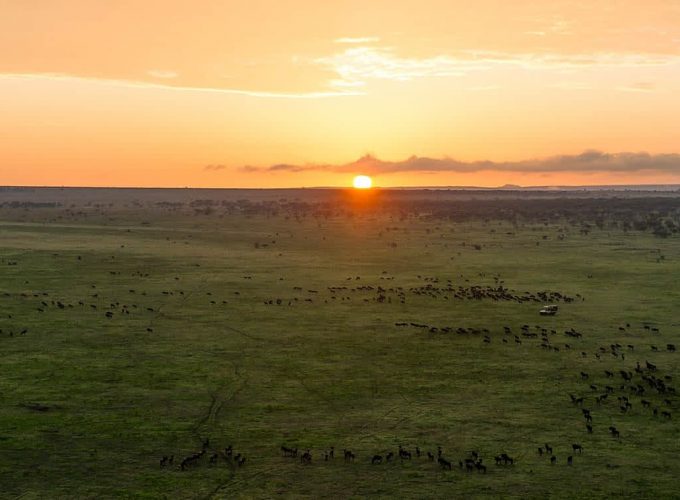The Serengeti National Park in Tanzania was established in 1952. It is home to the greatest wildlife spectacle on earth – the great migration of wildebeest and zebra. The resident population of lions, cheetah, elephants, giraffes, and birds is also impressive. There’s a wide variety of accommodation available, from luxury lodges to mobile camps. The park covers 5,700 sq miles, (14,763 sq km), it’s larger than Connecticut, with at most a couple of hundred vehicles driving around.
The Park can be divided into 3 sections. The popular southern/central part (Seronera Valley), is what the Maasai called the “Serengeti”, the land of endless plains. It’s classic savannah, dotted with acacias and filled with wildlife. The western corridor is marked by the Grumeti River and has more forests and dense bush. The north, Lobo area, meets up with Kenya’s Masai Mara Reserve, is the least visited section.
How to get here:
Fly to the Serengeti National Park
There are several airstrips within the Serengeti National Park, that are served by daily flights from places like Dar es Salaam, Arusha, Mafia Island, Pemba Island, Zanzibar, Ruaha NP, as well as from Uganda, Rwanda, and Kenya.
From the moment you fly over the Serengeti, your game drive has started. As these flights are all made with relatively small planes, you can look out the window and start spotting animals from the sky.
It is also possible to start your trip with a flight to Arusha, Kilimanjaro International Airport or Mwanza and drive from there.
Book your cheap flight to the Serengeti National Park with Tripindigo today and start the safari of a lifetime.
-
Drive to the Serengeti National Park
From Arusha and Kilimanjaro International Airport, it takes about 8 hours of driving to get to the Serengeti National Park, most of it on dirt roads.
If you have booked your flight to Mwanza you can enter the Serengeti from the west and start in the western corridor. The gate there is around 2-3 hours’ drive from Mwanza airport depending on traffic in town.
Main Attractions
The annual wildebeest migration
Serengeti National Park is The quintessential safari experience. The annual wildebeest migration has to be one of the most stunning natural phenomena ever. Roughly following the rains in a clockwise circular route, tracking the wildebeest, often accompanied by thousands of zebra and other antelopes, can bring magical moments to your safari.
Spotting the big 5 on your safari in the Serengeti
Once you have witnessed the annual migration of the wildebeest, there are plenty of other animals waiting to be enjoyed. The vast plains are home to ‘the big 5’. Lion, leopard, elephant, rhino, and buffalo are all here, so try and check them all off your list.
Leopard is relatively easy to spot in the Seronera (central) area due to the lack of hiding places here. Once the leopard is spotted in a tree or on a kopje, your guide will be told by the other guides and he can easily take you there for a relaxed look.
Buffalo, elephant, and lion are all quite easy to find in the Serengeti. The one that will be harder to find is the rhino.
Flying over the Serengeti in a hot air balloon
One of the amazing opportunities in the Serengeti is to get an aerial view over the endless grasslands, dotted with kopjes (rocky mounds) and typical umbrella trees. Absorb the mesmerizing scenery of the Serengeti, teeming with wildlife as the sun rises, before touching down for a champagne breakfast. Romantic, breathtaking, enchanting, a ‘once in a lifetime’ experience, Serengeti National Park is waiting for you.
The crossing of thousands of wildebeest and zebras during the migration
With patience and a good dose of luck (and timing your trip to be in the correct season), you can watch the wildebeest and zebras tentatively start a river crossing. Once they start, the dust will rise and the rest will follow. The spectacle is incredible, there are no words to describe it, it is just overwhelming.
Crocodiles will be lurking in the river and lions can be on either side of the bank waiting for their opportunity. It is nature at its purest.
Experiencing the wildebeest calving season
Witness the incredible mass births of wildebeest calves. Predators are of course everywhere waiting for opportunities, harsh reality of birth and death so closely linked together.
But as thousands are born in a relatively short period, this ensures nearly all survive as there are too many for the predators to kill. If you time your visit right you can be part of this clever trick of nature to ensure the survival of a species.
Bird watching in the Serengeti
Bird lovers will love the Serengeti National Park. More than 500 species have been recorded in a huge variety of habitats. And some of the endemic birds are not hard to spot, for example, the Fischer’s lovebird, the grey-breasted spurfowl, and the Rufous-tailed weaver. But of course, you can also find different barbets, pretty kingfishers, colorful bee-eaters, and incredible birds of prey including many vultures.

